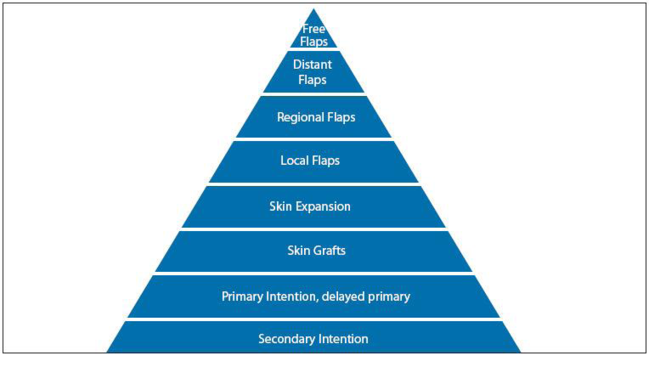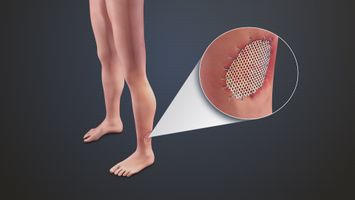Reconstruction Post Burn: Difference between revisions
No edit summary |
No edit summary |
||
| Line 1: | Line 1: | ||
<div class="editorbox"> '''Original Editor '''- [[User:User Name|User Name]] '''Top Contributors''' - {{Special:Contributors/{{FULLPAGENAME}}}}</div> | |||
<div class="noeditbox">This article or area is currently under construction and may only be partially complete. Please come back soon to see the finished work! ({{REVISIONDAY}}/{{REVISIONMONTH}}/{{REVISIONYEAR}})</div> | <div class="noeditbox">This article or area is currently under construction and may only be partially complete. Please come back soon to see the finished work! ({{REVISIONDAY}}/{{REVISIONMONTH}}/{{REVISIONYEAR}})</div> | ||
| Line 5: | Line 7: | ||
== Aims of post burn reconstruction == | == Aims of post burn reconstruction == | ||
# | # Cosmetic enhancement | ||
# Reduce functional restrictions | # Reduce functional restrictions and contraction | ||
# | # Prevention of infections | ||
# Achieve wound closure | # Achieve wound closure | ||
# Re-establish tissue loss | # Re-establish tissue loss | ||
== Method of reconstruction == | == Method of reconstruction == | ||
Choosing the correct method of reconstruction, depend on the extent of the missing tissue and the structures affected. The reconstructive | Choosing the correct method of reconstruction, depend on the extent of the missing tissue and the structures affected. The reconstructive methods are applied in a hierarchy as per the reconstructive ladder (Figure 1). Starting from the simplest procedure such as Split Skin Grafts on the first step to compound tissue transfer by Micro vascular surgery at the other extreme. <ref>Hale A, O’Donovan R, Diskin S, McEvoy S, Keohane C, Gormley G. Physiotherapy in burns, plastics and reconstructive surgery. Impairment and Disability Course University of Limerick. Irlandia: The Educational Company of Ireland. 2013 Apr 19:2-6.</ref> | ||
[[File:Burn reconstruction ladder.png|center|thumb|649x649px]] | [[File:Burn reconstruction ladder.png|center|thumb|649x649px]] | ||
Figure 1 The reconstructive ladder, procedures ranging from simplest to most complex. | Figure 1: The reconstructive ladder, procedures ranging from simplest to most complex. | ||
=== | === Skin graft === | ||
[[File:Skin Grafting.jpg|thumb|355x355px|https://commons.wikimedia.org/w/index.php?curid=74549936]] | [[File:Skin Grafting.jpg|thumb|355x355px|https://commons.wikimedia.org/w/index.php?curid=74549936]] | ||
A skin graft is the transportation of skin from one area of the body to another.A graft is an area of skin that is separated from its own blood supply and requires a highly vascular recipient bed in order for it to be successful. Prior to grafting, the process of wound debridement must take place. Wound debridement involves removing necrotic tissue, foreign debris, and reducing the bacterial load on the wound surface.This is believed to encourage better healing. The following are the methods available for grafting onto a debrided wound to obtain closure: | A skin graft is the transportation of skin from one area of the body to another. A graft is an area of skin that is separated from its own blood supply and requires a highly vascular recipient bed in order for it to be successful. Prior to grafting, the process of wound debridement must take place. Wound debridement involves removing necrotic tissue, foreign debris, and reducing the bacterial load on the wound surface. This is believed to encourage better healing. The following are the methods available for grafting onto a debrided wound to obtain closure: | ||
* Autograft (‘split skin graft’) (own skin) | * Autograft (‘split skin graft’) (own skin) | ||
| Line 47: | Line 49: | ||
== Implications for physiotherapy == | == Implications for physiotherapy == | ||
Physiotherapists must work as part of Multi Disciplinary Team (MDT) in order to ensure successful surgery while at the same time ensuring long term health and function. To gain the optimal result from any reconstructive surgery [[Scar Management|scar]] management needs to recommence and be followed through until scars are mature and optimal range of movement gained. Reconstructive surgery injures the skin again and the potential physiological scarring process recurs | |||
=== Scar management === | === Scar management === | ||
Cover the principles and aspects of therapy described below: | |||
• | • Oedema management | ||
• | • Exercise | ||
• [[Splinting for Burns| | • [[Splinting for Burns|Splinting]] and positioning | ||
• | • Compression garments | ||
• | • Silicone and scar softening products | ||
• | • Skin care | ||
• | • Massage. | ||
== Reference == | == Reference == | ||
<references /> | <references /> | ||
Revision as of 14:50, 6 December 2020
Introduction[edit | edit source]
After a severe burn trauma, often acute burn surgery is needed in order to provide a foundation for the affected skin areas to heal. However, after treating the burned areas under acute surgery, wounds do not always heal well within in the following weeks or months. In cases where the first surgery was either not very effective or scar tissue has build up, reconstructive burn surgery may be indicated. This option is often used to "improve both the function and the cosmetic appearance of burn scars".[1] Scars will thus be less prominent and apparent which is a major influencing factor for the psychological affect burn wounds can have on a person.[2] Through the procedure the affected skin will allow for more flexibility and movement capacity, which may, depending on the location of the burned area, also improve joint flexibility.
Aims of post burn reconstruction[edit | edit source]
- Cosmetic enhancement
- Reduce functional restrictions and contraction
- Prevention of infections
- Achieve wound closure
- Re-establish tissue loss
Method of reconstruction[edit | edit source]
Choosing the correct method of reconstruction, depend on the extent of the missing tissue and the structures affected. The reconstructive methods are applied in a hierarchy as per the reconstructive ladder (Figure 1). Starting from the simplest procedure such as Split Skin Grafts on the first step to compound tissue transfer by Micro vascular surgery at the other extreme. [3]
Figure 1: The reconstructive ladder, procedures ranging from simplest to most complex.
Skin graft[edit | edit source]
A skin graft is the transportation of skin from one area of the body to another. A graft is an area of skin that is separated from its own blood supply and requires a highly vascular recipient bed in order for it to be successful. Prior to grafting, the process of wound debridement must take place. Wound debridement involves removing necrotic tissue, foreign debris, and reducing the bacterial load on the wound surface. This is believed to encourage better healing. The following are the methods available for grafting onto a debrided wound to obtain closure:
- Autograft (‘split skin graft’) (own skin)
- Allograft (donor skin)
- Heterograft or xenografts (animal skin)
- Cultured skin
- Artificial skin
Skin flap[edit | edit source]
A skin flap consists of skin and subcutaneous tissue that survives based on its own blood supply. Skin flaps are classified by the source and pattern of that blood supply.
- Vascularity:
- Anatomical composition:
- Method of relocation:
Template:Https://youtu.be/1CncffOIZis
Treatment procedures[edit | edit source]
Reconstructive burn surgery is undertaken by plastic surgeons often with specialisation in reconstructive burn surgery. Skin, tendons and other tissues that were damaged through the burn can be replaced or reconstructed.
Alpoecia (hair loss) treatment after burns[edit | edit source]
If the skin of the scalp was damaged by a burn trauma, hair follicles can be destroyed which results in hair loss. In order to recreate hair growth, healthy, undamaged skin is stretched and transplanted.[2] Hair transplantation is another treatment possibility. For this procedure hair follicles are taken from healthy parts of the scalp to the damaged skin.
Breast and nipple-areola reconstruction[edit | edit source]
Breast and especially nipple-areola reconstruction surgery can be performed in various techniques and is subject to extensive research, since surgery does not always significantly improve the outcome.[4]
Implications for physiotherapy[edit | edit source]
Physiotherapists must work as part of Multi Disciplinary Team (MDT) in order to ensure successful surgery while at the same time ensuring long term health and function. To gain the optimal result from any reconstructive surgery scar management needs to recommence and be followed through until scars are mature and optimal range of movement gained. Reconstructive surgery injures the skin again and the potential physiological scarring process recurs
Scar management[edit | edit source]
Cover the principles and aspects of therapy described below:
• Oedema management
• Exercise
• Splinting and positioning
• Compression garments
• Silicone and scar softening products
• Skin care
• Massage.
Reference[edit | edit source]
- ↑ Reconstructive burn sugery. Michigan Medicine, University of Medicine. Available at:https://www.uofmhealth.org/conditions-treatments/surgery/plastic/burn-reconstructive (accessed 30. November 2020).
- ↑ 2.0 2.1 Post Burn Reconstruction. Nora Nugent. Available from: https://www.noranugent.co.uk/post-burn-reconstruction/ (accessed 30 November 2020).
- ↑ Hale A, O’Donovan R, Diskin S, McEvoy S, Keohane C, Gormley G. Physiotherapy in burns, plastics and reconstructive surgery. Impairment and Disability Course University of Limerick. Irlandia: The Educational Company of Ireland. 2013 Apr 19:2-6.
- ↑ Postburn reconstruction of nipple-areola complex. Motamed S, Davami B. Burns 2005; 31:1020-24.








